Carla Accardi *

(Trapani 1924–2014 Rome)
Integrazione n. 2, 1957, signed and dated; signed on the reverse, casein on canvas, 63 x 88 cm, framed
This work is registered at Studio Accardi, Rome under no. 91/10 and is accompanied by a photo certificate issued by Studio Accardi and signed by the artist.
Provenance:
Porro & C, Milan, 16 November 2010, lot 76
European Private Collection
During the first half of the 1950s, the groundwork was laid for the profound internationalisation of artistic culture in Italy: while Italian gallery owners undertook an ever-increasing number of exhibitions overseas, Venturi gave lectures on the New York avant-garde and the art world admired Pollock’s first photos, showing him making his drip-images.
Carla Accardi saw her career mature during this period of flux. Born in Sicily, she moved to Florence in order to continue her studies, and subsequently to Rome, where she married Antonio Sanfilippo and joined the Forma group.
The decade from 1950 to 1960 was a crucial period of experimentation and artistic maturity for Accardi. Up to that point, her work had developed in the field of concrete painting, which she picked up and took on in Paris, in particular. From 1953 onwards, her work followed a new direction based on the poetics of the sign. Initially still pursuing an idea of a ‘figure’, it primarily drew on earthy shades. In the years to follow, it developed to become sets of segments articulated by dry, alternating arrangements of black and white, sometimes with red added. “I used white on black,” she explained, “because black on white didn’t excite me as it was too obvious; in that particular moment the artist has to have a sense of uniqueness, of novelty that spurs them on.”
The photographs depicting Accardi at work often immortalise her on the floor or on a table, but never at an easel; the signs on her canvases must be able to expand without limits, without spatial constraints, intertwining or moving away freely. This is precisely the case with Integrazione n. 2. In this piece, a nucleus of energy generated by a set of individual elements in dialogue with each other gives life to mysterious two-dimensional abstract writings that negate the distance between the background and the sign.
In Accardi’s oeuvre, the signs are never random, but always subject to a certain reasoning in terms of form. The form of her works is thus determined by the various groupings of signs, and the force or her compositions arises from the complexity and variety of the signs’ aggregations.
In the fifties, Accardi’s works found great support in the form of the critic and prophet of art informel Michel Tapié, who documented her artistic output and that of her husband Sanfilippo in ground-breaking publications such as Esthétique en devenir (1956) and Morphologie autre (1960). He also promoted her works in important exhibitions alongside the most established American, European and Japanese painters, leading to her being fully accepted as exponents of art autre.
In the 50s and 60s, Accardi’s work is characterised by the idea of a sort of anti-painting made of contrasts, of reversals, which aims to subvert the hierarchy of forms and colours, of the relationships between absolute and individual vision, passing through the dissolution and crisis of tradition. Her idiosyncratic style is defined by a central nucleus of centripetal energy which leads the margins of the pictorial surface to be seen as a background. Every sign exists in relation to other signs and with them, they form a structure that acquires meaning through the whole and becomes artistic expression itself.
Specialist: Alessandro Rizzi
 Alessandro Rizzi
Alessandro Rizzi
+39-02-303 52 41
alessandro.rizzi@dorotheum.it
24.06.2020 - 16:00
- Realized price: **
-
EUR 106,550.-
- Estimate:
-
EUR 75,000.- to EUR 100,000.-
Carla Accardi *
(Trapani 1924–2014 Rome)
Integrazione n. 2, 1957, signed and dated; signed on the reverse, casein on canvas, 63 x 88 cm, framed
This work is registered at Studio Accardi, Rome under no. 91/10 and is accompanied by a photo certificate issued by Studio Accardi and signed by the artist.
Provenance:
Porro & C, Milan, 16 November 2010, lot 76
European Private Collection
During the first half of the 1950s, the groundwork was laid for the profound internationalisation of artistic culture in Italy: while Italian gallery owners undertook an ever-increasing number of exhibitions overseas, Venturi gave lectures on the New York avant-garde and the art world admired Pollock’s first photos, showing him making his drip-images.
Carla Accardi saw her career mature during this period of flux. Born in Sicily, she moved to Florence in order to continue her studies, and subsequently to Rome, where she married Antonio Sanfilippo and joined the Forma group.
The decade from 1950 to 1960 was a crucial period of experimentation and artistic maturity for Accardi. Up to that point, her work had developed in the field of concrete painting, which she picked up and took on in Paris, in particular. From 1953 onwards, her work followed a new direction based on the poetics of the sign. Initially still pursuing an idea of a ‘figure’, it primarily drew on earthy shades. In the years to follow, it developed to become sets of segments articulated by dry, alternating arrangements of black and white, sometimes with red added. “I used white on black,” she explained, “because black on white didn’t excite me as it was too obvious; in that particular moment the artist has to have a sense of uniqueness, of novelty that spurs them on.”
The photographs depicting Accardi at work often immortalise her on the floor or on a table, but never at an easel; the signs on her canvases must be able to expand without limits, without spatial constraints, intertwining or moving away freely. This is precisely the case with Integrazione n. 2. In this piece, a nucleus of energy generated by a set of individual elements in dialogue with each other gives life to mysterious two-dimensional abstract writings that negate the distance between the background and the sign.
In Accardi’s oeuvre, the signs are never random, but always subject to a certain reasoning in terms of form. The form of her works is thus determined by the various groupings of signs, and the force or her compositions arises from the complexity and variety of the signs’ aggregations.
In the fifties, Accardi’s works found great support in the form of the critic and prophet of art informel Michel Tapié, who documented her artistic output and that of her husband Sanfilippo in ground-breaking publications such as Esthétique en devenir (1956) and Morphologie autre (1960). He also promoted her works in important exhibitions alongside the most established American, European and Japanese painters, leading to her being fully accepted as exponents of art autre.
In the 50s and 60s, Accardi’s work is characterised by the idea of a sort of anti-painting made of contrasts, of reversals, which aims to subvert the hierarchy of forms and colours, of the relationships between absolute and individual vision, passing through the dissolution and crisis of tradition. Her idiosyncratic style is defined by a central nucleus of centripetal energy which leads the margins of the pictorial surface to be seen as a background. Every sign exists in relation to other signs and with them, they form a structure that acquires meaning through the whole and becomes artistic expression itself.
Specialist: Alessandro Rizzi
 Alessandro Rizzi
Alessandro Rizzi
+39-02-303 52 41
alessandro.rizzi@dorotheum.it
|
Buyers hotline
Mon.-Fri.: 10.00am - 5.00pm
kundendienst@dorotheum.at +43 1 515 60 200 |
| Auction: | Contemporary Art I |
| Auction type: | Saleroom auction |
| Date: | 24.06.2020 - 16:00 |
| Location: | Vienna | Palais Dorotheum |
| Exhibition: | 18.06. - 24.06.2020 |
** Purchase price incl. charges and taxes
It is not possible to turn in online buying orders anymore. The auction is in preparation or has been executed already.
